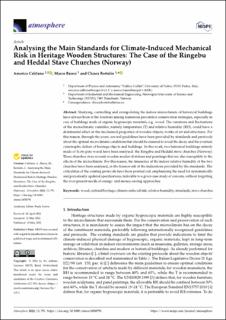| dc.contributor.author | Califano, America | |
| dc.contributor.author | baiesi, marco | |
| dc.contributor.author | Bertolin, Chiara | |
| dc.date.accessioned | 2023-02-02T11:51:16Z | |
| dc.date.available | 2023-02-02T11:51:16Z | |
| dc.date.created | 2022-07-11T15:53:56Z | |
| dc.date.issued | 2022 | |
| dc.identifier.citation | Atmosphere. 2022, 13 (5), . | en_US |
| dc.identifier.issn | 2073-4433 | |
| dc.identifier.uri | https://hdl.handle.net/11250/3047979 | |
| dc.description.abstract | Studying, controlling and extrapolating the indoor microclimate of historical buildings have always been at the forefront among numerous preventive conservation strategies, especially in case of buildings made of organic hygroscopic materials, e.g., wood. The variations and fluctuations of the microclimatic variables, namely temperature (T) and relative humidity (RH), could have a detrimental effect on the mechanical properties of wooden objects, works of art and structures. For this reason, through the years, several guidelines have been provided by standards and protocols about the optimal microclimatic conditions that should be ensured to avoid the decay and the eventual catastrophic failure of heritage objects and buildings. In this work, two historical buildings entirely made of Scots pine wood have been analysed: the Ringebu and Heddal stave churches (Norway). These churches store several wooden medieval statues and paintings that are also susceptible to the effects of the microclimate. For this reason, the timeseries of the indoor relative humidity of the two churches have been analysed, in the framework of the indications provided by the standards. The criticalities of the existing protocols have been pointed out, emphasizing the need for systematically and periodically updated specifications, tailorable to a given case study of concern, without forgetting the ever-present needs of energy- and money-saving approaches. | en_US |
| dc.language.iso | eng | en_US |
| dc.publisher | MDPI | en_US |
| dc.rights | Navngivelse 4.0 Internasjonal | * |
| dc.rights.uri | http://creativecommons.org/licenses/by/4.0/deed.no | * |
| dc.title | Analysing the Main Standards for Climate-Induced Mechanical Risk in Heritage Wooden Structures: The Case of the Ringebu and Heddal Stave Churches (Norway) | en_US |
| dc.title.alternative | Analysing the Main Standards for Climate-Induced Mechanical Risk in Heritage Wooden Structures: The Case of the Ringebu and Heddal Stave Churches (Norway) | en_US |
| dc.type | Peer reviewed | en_US |
| dc.type | Journal article | en_US |
| dc.description.version | publishedVersion | en_US |
| dc.source.pagenumber | 15 | en_US |
| dc.source.volume | 13 | en_US |
| dc.source.journal | Atmosphere | en_US |
| dc.source.issue | 5 | en_US |
| dc.identifier.doi | 10.3390/atmos13050791 | |
| dc.identifier.cristin | 2037996 | |
| dc.relation.project | Norges forskningsråd: 274749 | en_US |
| cristin.ispublished | true | |
| cristin.fulltext | original | |
| cristin.qualitycode | 1 | |

